Understanding SAP Energy Assessments in the UK
When it comes to buying, building or selling a home in the UK, most of us will hear something about energy ratings, EPCs and SAP assessments. If these terms sound confusing, you’re not alone. Many homeowners don’t fully understand how these assessments work, why they’re needed, or how they affect a property.
We’re here to break it down in a way that’s simple and helpful. At Ratio Seven, we work with homeowners, builders and developers across the country to carry out SAP calculations and domestic energy assessments that help new homes meet regulations and boost their energy performance.
What is a SAP Energy Assessment?
SAP stands for Standard Assessment Procedure. It’s the method used by the UK government to work out the energy performance of a home. Every newly built or converted home must have a SAP assessment and an official Energy Performance Certificate (EPC) before it can be sold or rented.
This process looks at things like:
- Construction materials
- Heating systems
- Insulation levels
- Windows and doors
- Air leakage and draught-proofing
- Lighting and fixed appliances
By feeding all this information into a computer model, an assessor can work out how much energy the home is expected to use for heating, hot water, lighting and ventilation.
The SAP score is then turned into an energy rating between A and G. A-rated homes use the least energy, while G-rated ones use the most.
You can read more about this process and how we can help on the Ratio Seven site under our section on domestic energy assessments in the UK.
When Do You Need a SAP Calculation?
You’ll need a SAP calculation before you can get a final EPC for a property, and that EPC is required before a home can be put up for sale or let.
You’ll also need SAP assessments if:
- You are building a new home
- A property is being converted from commercial use to residential use
- Multiple flats are being created from a single dwelling, like splitting a house into flats
- You are making major extensions that contain habitable rooms (like a new bedroom or a large kitchen-diner)
A SAP calculation should be done as early as possible in the planning and design process. Why? Because it gives you the chance to tweak your plans to meet energy standards and avoid delays later. Our team at Ratio Seven can guide you through this right from the design stage to make sure everything is covered.
The Role of Part L of Building Regulations
One of the main reasons SAP calculations exist is to help properties meet Part L of the Building Regulations. Part L deals with energy use in buildings and sets the rules around how homes should be insulated and heated.
If your new build or large renovation doesn’t meet Part L standards, then a completion certificate won’t be issued, and that means you won’t legally be able to sell or rent the property.
A full SAP report will help to prove compliance with Part L. The same report helps provide the EPC that you need for the property’s future sale or rental.
So, although it might sound complex, the SAP process is simply part of making sure all homes are built to be warm, well-insulated and not waste energy.
What Happens During a SAP Assessment?
Let’s go through the process in an easy-to-follow order:
Step 1: Plans and Drawings
First, we’ll need detailed building plans, technical drawings and information about your materials and specifications. These usually come from your architect.
Step 2: SAP Calculations
Using official government software, we enter all the data to calculate the expected energy use. This includes how thick your insulation is, the type of boiler or heat pump you’re using, and how much glazing is in the design.
Step 3: Design Changes (if needed)
If your planned build doesn’t meet Part L requirements, we’ll make suggestions that could help you comply, maybe boosting insulation or changing windows.
Step 4: Final Assessment Once Built
After the building is complete, we carry out a final report. This leads to a full EPC being issued. You’ll need this document if you’re planning to sell or rent the home.
Throughout this whole process, our aim at Ratio Seven is to make things as stress-free as possible. Lots of clients tell us they had no idea what a SAP was before they started working with us, and by the end, they’ve picked up a few things along the way.
How SAP is Different From an EPC
People often confuse SAP assessments with Energy Performance Certificates, but they’re not the same.
The SAP is the actual calculation. It’s based on the design and intended construction of the home before building is finished. It uses fixed data and calculations to score a property’s predicted energy use.
The EPC is the document that shows the outcome of this SAP result. It displays the home’s score and grade from A to G, much like the coloured label you’d see on a fridge or washing machine.
While existing homes get an EPC based on how they look and function in real life, a new build’s EPC is based on what’s been submitted via the SAP score. So, without the SAP figures, an EPC can’t be produced properly for a new home.
That’s why SAP calculations are needed first, they’re the foundation of the final energy rating a home will get.
Why Homeowners Should Care About SAP Reports
We sometimes hear this question: “Do I need to worry about this if my builder or architect is sorting it out?”
It’s fair to trust your professionals. But understanding your SAP score yourself has real benefits, especially if you plan to live in the property.
A home built to a better energy standard can mean:
- Lower bills for heating and hot water
- Fewer draughts
- More comfort in cold months
- Less impact on the environment
- A higher selling price down the line
So it’s not just about paperwork. A higher SAP rating really can make your home better to live in. And for landlords or developers, it can make your property more attractive to buyers and tenants, too.
We help hundreds of homeowners understand these scores so they can make choices that bring real rewards. You can get in touch with us by visiting Ratio Seven online.

Common Questions Homeowners Ask About SAP
Can a SAP score be improved after it’s been calculated?
Yes, before the build is finished. If we’re working with a poor score during the design phase, we can offer advice to improve things. Once the house is built, there’s little room to change the official outcome.
Do I need a SAP for an extension?
Not always, but if your extension includes new rooms that are lived in (like a bedroom or lounge), then yes. SAP calculations for extensions are slightly different and often look at how the new space affects the overall house.
How long does a SAP assessment take?
If we have full details and drawings, the first round of SAP results usually takes a couple of days. If changes are needed, it depends on how quickly updated plans are received.
Can I fail a SAP assessment?
Not in the way you might fail a test. But if the score is too low, your build may not meet Building Regulations. That’s why we work with you to adjust the design and help you reach approval.
Choosing a SAP Assessor – Why We’re Different
There are lots of companies offering SAP assessments, but not all offer the same level of advice and customer care.
At Ratio Seven, we’re not just here to do the calculation and send a number. We’re part of your team, working with you from the early design stage right through to completion. Whether you’re building one house or ten, we help identify the steps that make a real difference.
We take the time to explain things clearly, answer questions and make sure no detail is missed. Clients return to us again and again, not just for the result, but for the way we care about the process, too.
You can find more about our services at Ratio Seven.
Final Thoughts & Next Steps
Understanding SAP assessments doesn’t have to feel overwhelming. Now that you know what they are, why they matter, and how they fit into your project, you’ll be in a stronger position to make smart choices about your home. From design tweaks to proper insulation, a good SAP score gives your home a better future.
If you’re planning a new build or conversion, Ratio Seven can help with every stage of your SAP assessment and ensure your project meets the latest regulations. Need advice or just want a quick quote? Visit Ratio Seven and start the journey toward a better-rated home today.




